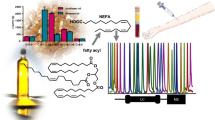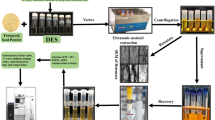Abstract
The content of the two flavonoids, luteolin and luteoloside, in dandelions was determined by high-performance liquid chromatography. A Nucleosil®100-5C18 column was used for the determination of luteolin and luteoloside concentrations. The mobile phase was a mixture of acetonitrile and water containing 0.1% formic acid (99.9:0.1, v/v). The gradient elution program was 10% to 23% acetonitrile within 60 min at a flow rate of 1.0 mL·min−1. The ultraviolet spectra were recorded at 350 nm for the identification of the two flavonoids. The contents of luteolin and luteoloside were highest in T. officinale flowers (5.817 ± 0.030 mg·g−1) and in T. coreanum leaves (6.205 ± 0.087 mg·g−1), respectively. The total content of luteolin and luteoloside in T. coreanum was about 1.3–2 times higher than that found in T. ohwianum and T. officinale.
Similar content being viewed by others
Literature Cited
Akashi, T., T. Furuno, T. Takahashi, and S.I. Ayabe. 1994. Biosynthesis of triterpenoids in cultured cells, and regenerated and wild plant organs of Taraxacum officinale. Phytochemistry 36:303–308.
Faber, K. 1958. Dandelion-Taraxacum officinale Weber. Pharmazie 13:423–436.
Hänsel, R., M. Kartarahardja, J.T. Huang, and F. Bohlmann. 1980. Sesquiterpenlacton-ß-D-glucopyranoside sowie ein neues Eudesmanolid aus Taraxacum officinale. Phytochemistry 19:857–861.
Hartwig, U.A., C.A. Maxwell, C.M. Joseph, and D.A. Phillips. 1990. Chrysoeriol and luteolin released from Alfalfa seeds induce nod genes in Rhizobium meliloti. Plant Physiol. 92:116–122.
Ho, C., E.J. Choi, G.S. Yoo, K.M. Kim, and S.Y. Ryu. 1998. Desacety lmatricarin, an anti-allergic component from Taraxacum platycarpum. Planta Med. 64:577–578.
Hook, I., A. McGee, and M. Henman. 1993. Evaluation of dandelion for diuretic activity and variation in potassium content. Int. J. Pharmacol. 31:29–34.
Hu, C. and D.D. Kitts. 2004. Luteolin and luteolin-7-O-glucoside from dandelion flower suppress iNOS and COX-2 in RAW264.7 cells. Mol. Cellul. Biochem. 265:107–113.
Hu, C. and D.D. Kitts. 2005. Dandelion (Taraxacum officinale) flower extract suppresses both reactive oxygen species and nitric oxide and prevents lipid oxidation in vitro. Phytomedicine 12:588–597.
Jung, M.J., S.S. Kang, H.A. Jung, G.A. Kim, and J.S. Choi. 2004. Isolation of flavonoids and cerebroside from the stem bark of Albizzia julibrissin. Arch. Pharm. Res. 27:593–599.
Khan, I.A. and E.A. Abourashed. 2010. Leung’s Encyclopedia of Common Natural Ingredients. Used in Food, Drugs and Cosmetics, John Wiley & Sons, New Jersey, U.S.A.
Kisiel, W. and B. Barszcz. 2000. Further sesquiterpenoids and phenolics from Taraxacum officinale. Fitoterapia 71:269–273.
Kisiel, W. and K. Michalska. 2006. Matricarin-type guaianolides from Taraxacum bessarabicum and their chemotaxonomic significance. Biochem. Syst. Ecol. 34:356–359.
Lee, H.H. and S.Y. Lee. 2008. Cytotoxic and antioxidant effects of Taraxacum coreanum Nakai and T. officinale WEB. extracts. Korean J. Medicinal Crop Sci. 16:79–85.
Markham, K.R., V.M. Chari., and T.J. Mabry. 1982. Carbon-13 NMR spectroscopy of flavonoids. In “The flavonoids: Advances in research”, Chapman & Hall, London, England.
Michalska, K. and W. Kisiel. 2003. Sesquiterpene lactones from Taraxacum obovatum. Planta Med. 69:181–183.
Shin, K.H., S.S. Kang, E.A. Seo, and S.W. Shin. 1995. Isolation of aldose reductase inhibitors from the flowers of Chrysanthemum boreale. Arch. Pharm. Res. 18:65–68.
Sweeney, B., M. Vora, C. Ulbricht, and E. Basch. 2005. Evidence-based systematic review of dandelion (Taraxacum officinale) by natural standard research collaboration. J. Herb. Pharmacother. 5:79–93.
Takasaki, M., T. Konoshima, H. Tokuda, K. Masuda, Y. Arai, K. Shiojima, and H. Ageta. 1999. Anti-carcinogenic activity of Taraxacum plant. I. Biol. Pharm. Bull. 22:602–605.
Tita, B., U. Bello, P. Faccendini, R. Bartolini, and P. Bolle. 1993. Taraxacum officinale W.: Pharmacological effect of ethanol extract. Pharmacol. Res. 27:23–24.
Williams, C.A., F. Goldstone, and J. Greenham. 1996. Flavonoids, cinnamic acids and coumarins from the different tissues and medicinal preparations of Taraxacum officinale. Phytochemistry 42:121–127.
Wolbis, M., M. Królikowska, and P. Bednarek. 1993. Polyphenolic compounds in Taraxacum officinale. Acta Pol. Pharm.-Drug Res. 50:153–158.
Author information
Authors and Affiliations
Corresponding author
Rights and permissions
About this article
Cite this article
Lee, S., Han, S., Kim, H.M. et al. Simultaneous determination of luteolin and luteoloside in dandelions using HPLC. Hortic. Environ. Biotechnol. 52, 536–540 (2011). https://doi.org/10.1007/s13580-011-0214-5
Received:
Accepted:
Published:
Issue Date:
DOI: https://doi.org/10.1007/s13580-011-0214-5




